
I remember the day I decided to sign up for Twitter. Like many other people at the time, I wondered why anyone would want to publicly broadcast their lives via 140 characters. It was early 2008, Twitter was about to skyrocket in growth, and I definitely wanted to get involved.
Once I joined, it didn’t take long for me to understand how powerful Twitter could be. I was hooked and jumped in full blast. Now, nearly five years—and 25K tweets—later, I figured it would be a good time to reflect on my time tweeting, consuming content, and connecting with others on Twitter.
A quick disclaimer: I’m not writing this because I think 25K tweets is some amazing milestone. It’s just a logical point at which to look back on my time on Twitter. 4.5 years is a long time (in digital terms), and 25K tweets is lot of content. It’s been an amazing ride so far, and I believe there are some important insights I’ve gleaned based on my time on Twitter. Let’s get started.
First, here’s the short version. If you want to learn more about the following bullets, then read the rest of my post. 🙂
- Fighting Through the Black Hole of Twitter
- The People I’ve Met
- The Doors Twitter Can Open
- Managing the Stream of Information
- The Business Impact of Twitter
- The Impact on Virality and SEO
- Twitter Compared to Other Social Networks
- The Advertising Obstacles
The Black Hole of Twitter
As with any social effort, you don’t gain traction overnight. This is critically important to understand for anyone jumping into Twitter, Facebook, Google Plus, etc. I wrote about the Black Hole of Blogging and Twitter a few years back, and the main concept holds true today.
When you start on Twitter (or any social network), you will have no followers, no traction, and no influence. The hard reality is that nobody will care when you post an update. You are tweeting to a black hole, and you need to fight through the black hole in order to start gaining traction.
Unfortunately, many people don’t sustain their efforts and then claim that Twitter doesn’t work for them. In my opinion, and based on my experience with Twitter, I believe you can start gaining traction at a few hundred (real) followers. But you still won’t gain a lot of traction (and experience a lot of engagement) until you build a larger and stronger following within your niche. That takes time, and there’s no way around it.
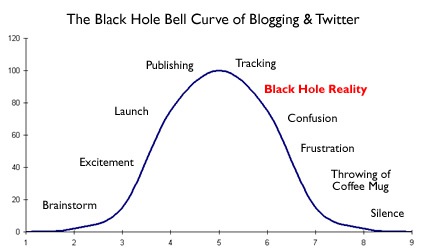
The People I’ve Met
I cannot emphasize enough how amazing it has been to connect with smart people on Twitter from across the country, and from around the world.
Whenever I speak about Twitter with people that haven’t jumped in yet (or that haven’t jumped in full blast), I notice they tend to talk about the social network and not the people on the social network. That always seemed weird to me, since social networks are all about people. That’s the foundation of Twitter, and it cannot be overlooked.
So, what can happen when you find and engage smart people across a number of targeted interests? Amazing things can happen. Let me explain further based on my own experience.
I’ve connected with @hollisthomases, who has proven to be an important mentor of mine as I launched and grew G-Squared Interactive. I’ve had dinner with @thelostagency, a smart Aussie digital marketer who I first met in 2010 on Twitter. I connected with @eric_andersen from IBM, a prolific Twitter user who reminds me of the FourSquare mayorships I’m missing across the Princeton area. I connected with @seosmarty, who asked if I wanted to write for Search Engine Journal in 2009. And that worked out pretty well. 🙂
I’ve chatted with @mblumenthal about local SEO quite a few times. I’ve read patents by Google, with a little help from @bill_slawski. I ran into the @bingads folks and started writing for their official blog. I’ve met some cool Canadians like @ruudhein and explained that there’s always American football if the NHL hockey season won’t be around this year. 😉
Oh, and I ended up writing for Search Engine People several times. I connected with @johnhdenny, another digital marketer from New Jersey, and met him in person at one of my presentations. I’ve got a Tel Aviv connection in @avinio, a smart digital marketer from Israel. I haven’t met him in person yet, but I’m confident I will some day.
And, I’ve had the opportunity to connect with other incredibly sharp marketers from around the country (and world) like @szetela, @schachin, @justin_fried, @steveplunkett, @steveakinsseo, @si1very, @aaranged, @leeodden, and many others. I can keep going here, but the post would be entirely too long. I think you get the picture.
What I just explained above is the true power of Twitter. I think the main takeaway is that Twitter enables you to connect with a targeted audience from all over the world. You can teleport from New York to Chicago to San Francisco to Sydney to London to Paris to Tel Aviv, and all within minutes.
And by the way, many of the people you connect with will be interested in similar topics. These are people that will inherently be interested about the updates you share, and they can amplify your own efforts (without you ever asking to do so). And at a time when tweets and retweets can lead to greater exposure, which can lead to increased traffic, and new customers, that’s darn powerful.
Finding and Then Engaging The Right People is What Twitter is All About
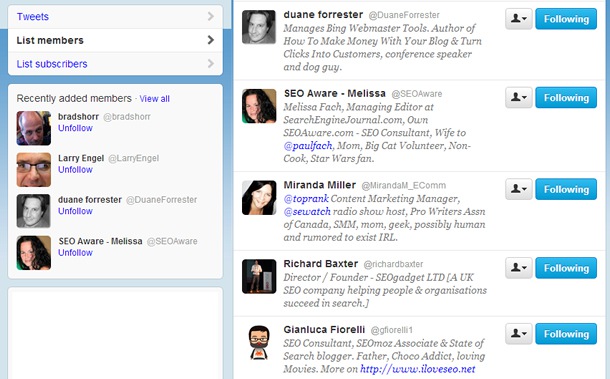
Twitter Tip: Like many in the industry, I believe follower count is overrated. My recommendation is to not focus on that number, but instead, focus on connecting with a smart group of people in a specific niche. I don’t care if that’s 1K, 5K, or 20K people. You’ll know when it makes sense.
The Doors Twitter Can Open and The Giant Doorstop
I wouldn’t advocate the power of Twitter to my clients unless I knew it could work for them. Twitter can absolutely open a ton of doors for professionals at any level. But, and this is an important point, you must build up respect in the community.
Nobody comes in pitching this and pitching that, and succeeds on Twitter. So, if Twitter can open doors, then posting updates about your own efforts all the time is the ultimate doorstop…
You need to build credibility, and that comes from hard work. And most importantly, it comes from thinking of others versus yourself. Don’t tweet about your own company over and over and expect new followers to roll in and the phone to ring. It takes a sustained and focused effort to build up a strong reputation on Twitter.
But if you do, amazing things can happen. From greater exposure in your industry to landing new jobs to speaking at conferences to landing new business—the sky is the limit. The past 4.5 years on Twitter for me have yielded some incredible moments.
Looking back, I call tell you first-hand that I would have missed so many opportunities without being heavily active on Twitter. This underscores an important point about my approach to Twitter. You need long-term and consistent participation in order to see success.
Bombarding Users With Self-Promoting Tweets is the Ultimate Doorstop
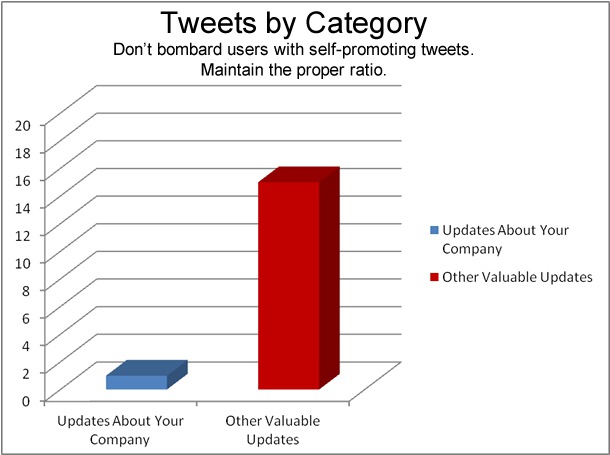
The Stream of Information (and the Importance of Filtering)
As Twitter has grown, and the number of people I’m following has grown, managing the inbound stream of information has been challenging. This is also something I often hear from new users or from clients just getting started with Twitter.
With an overwhelming number of tweets bombarding you on Twitter, it’s incredibly important to effectively manage that stream of information or you will be overloaded quickly. That’s why third-party tools are critically important. Without Tweetdeck panes (desktop) and my Twicca lists (Android), there’s no way I could logically organize Twitter users and their tweets.
Over time, I have created distinct lists of people by category, and that has worked out extremely well for me. Using these lists, I can quickly see tweets from people that focus on a given topic.
No matter the time of day or day of week, I can easily see the latest going on in SEO, Social Media Marketing, SEM, Analytics, Technology, Gadgets, etc. I can also keep track of certain brands, certain people (cough, @mattcutts), and Google itself. If you aren’t doing this already, take the time to get some killer third-party tools and organize your sources of information. You’ll never look back.
Twitter Lists Enable You To Organize Users by Category
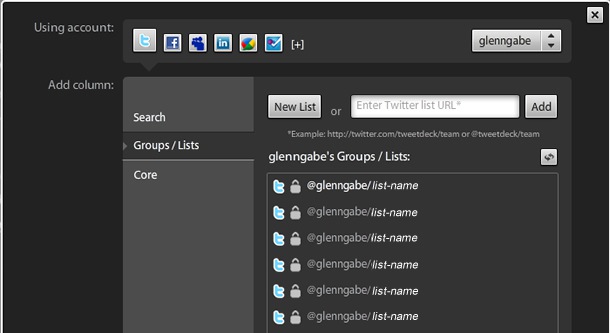
How Twitter Helps My Business
I’ve been asked a thousand times over the past few years, “It seems like Twitter takes so much time. Why do you keep doing it?” My answer is simple: “How are you not doing it??”
I view Twitter as a critical component to my business. It’s a part of my daily work routine and has been for 4.5 years. And I don’t envision that changing in the short-term either.
Via Twitter, I’m able to keep up on the latest in digital marketing no matter where I am. And that’s especially important given the pace of the industry. There are important updates on a near-daily basis in SEO, Social, Paid Search, Analytics, Technology, etc. Discovering, and then quickly internalizing those updates, can help my business, and the business of my clients.
For example, there are times a new release is broadcast by AdWords, Bing Ads, Facebook, etc., and I’m able to implement those changes the same day for my clients. That’s extremely powerful and helps my clients stay one step ahead of their competitors.
In addition, there have been times I walk into a meeting after reading breaking news and I’m able to use that information in the meeting (even 15 minutes after it was released). How powerful is that? From SEO news to business updates to changes in privacy policies to new product releases, I’m the type of person that wants to know about those updates immediately—and Twitter enables me to do that.
Using Twitter to Keep Track of Industry News is Critically Important to Me
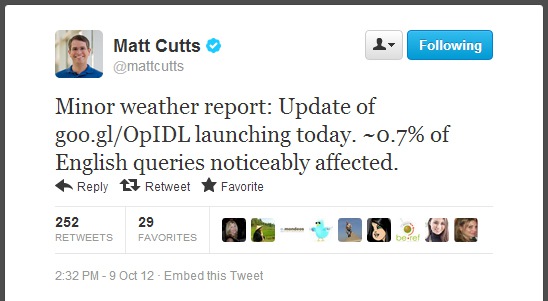
The Impact on Virality and SEO
It has been amazing to see the impact that Twitter can have on traffic over the past few years. From a marketing standpoint, Twitter can drive massive amounts of targeted traffic in a short period of time.
At G-Squared Interactive, I have the opportunity to help clients across several industries, so I get to see Twitter’s impact across a number of verticals. And it’s always incredible to watch a killer piece of content go viral on Twitter. Then it’s amazing to analyze those updates to gain perspective, and then view the longer-term impact on a business.
From an SEO perspective, many people outside of the Search industry don’t realize that Twitter (and Social in general) can have an effect on your SEO efforts. It goes something like this:
- Company does thorough research to understand a certain topic.
- Company builds killer content covering the topic.
- Company leverages its social connections (including Twitter) to share the new content.
- Content gains traction, more shares occur (including Tweets).
- Thousands of people within a niche view the content.
- A small percentage of those users are inspired to write about that content on their own blogs, forums, etc., and link back to the original post.
- Powerful and relevant links are built to the new content (naturally).
- The new content builds search power, helping that specific content rank better, but also strengthening the domain.
And I’m not even referring to social as a ranking factor (which it is), the ability have content crawled faster (which it can), etc. The core point is that platforms like Twitter can be your best friend when building and promoting new content.
If you’ve ever asked yourself, “How can I build links naturally??” Well, developing a strong following on Twitter can be a powerful way to do that. But, before you think it’s easy, reference the “black hole” section from earlier. 🙂
Content Goes Viral on Twitter and a Spike in Traffic Follows
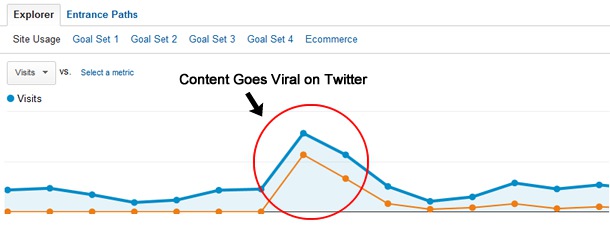
Compared to Other Major Social Networks
I often have people ask me my thoughts about Twitter versus Facebook and Google Plus. First, and most importantly, all of them can be powerful. You need to determine which combination of social efforts will pay off for your own company. But for me personally, Twitter has been the most powerful.
Now, I’m a heavy user of Google Plus, and I think it’s a powerful platform too, but Twitter is still my number one. There’s something about the ease of use, the quickness, the brevity of updates, the public nature of tweets, etc. It also has a large enough user base to support many different topics and industries.
And then of course, there are the privacy issues with other social networks that don’t seem to have hit Twitter (yet). We know Google can mine your information across services, and we definitely know Facebook has harvested a ton of information about you. But, Twitter seems more benign.
Don’t get me wrong, they have access to all of your tweets, your followers, the people you follow, your direct messages, etc., but most tweets are public (unless you protect your tweets). If you are posting publicly, then you should assume that content can be found, analyzed, etc.
So, I think it’s the public nature of Twitter that has shielded it from privacy concerns that have plagued other social networks. But, that very well could be short-lived, as Twitter ramps up its advertising efforts. Targeting for advertising comes from user data, and user data means your information. That’s a good segue to advertising obstacles.
As Twitter Ramps Up Its Advertising Platform, Privacy Concerns Will Follow
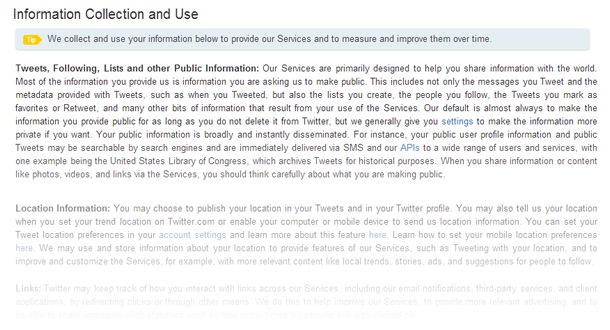
Twitter’s Advertising Obstacles
Given the importance of Twitter generating revenue, I’m even shocked that I put this section so late in the post. 🙂 As a heavy Twitter user, it’s hard to avoid the changes Twitter has been making in order to create a consistent and cohesive platform for advertisers. The plethora of third-party apps and services that have popped up over the years has led to an environment of inconsistent UI’s and experiences, which makes it very hard for Twitter to roll out advertising products. And let’s not forget that Twitter is a real business. That means it ultimately needs to make more money than it spends—and that’s no easy feat.
Twitter Needs to Build More Compelling and Higher ROI-focused Advertising Products
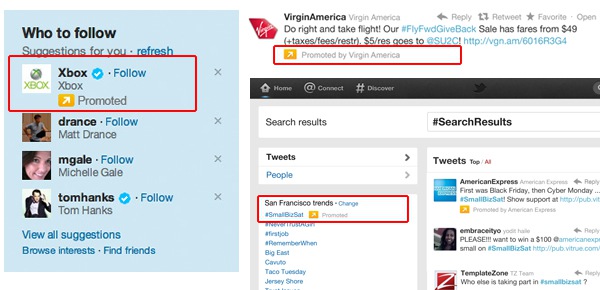
As many of you know, Twitter’s latest API changes rocked the Twitter ecosystem. And it all points to monetization. As a user, it’s hard to watch unpopular decisions being made based on money. But, as a digital marketer representing potential advertisers, I totally get it.
But even as Twitter aligns the platform with its advertising products, I think it could be a tough road for them. Don’t get me wrong, Twitter can absolutely generate a lot more revenue via advertising than it does now, but the current products seem relatively weak compared to the Google benchmark. To me, Twitter needs to create more compelling and higher ROI-focused advertising products, or their revenues may never meet expectations.
Also, consistently delivering advertising to users is a huge challenge for Twitter. Unfortunately, and I referenced this above, Twitter still has a serious problem with third-party apps. The fact of the matter is that I rarely visit Twitter.com, which is where most of Twitter’s advertising products work.
I use Tweetdeck on desktop and Twicca as my Android client, which means I barely see any advertising (other than a promoted tweet every now and then in Tweetdeck). And no, I haven’t clicked a single one. This underscores the problem Twitter will have trying to monetize user activity across the network.
That said, this is just the current state of Twitter advertising. There’s no doubt they will be continually rolling out new advertising products, and maybe even a search product. Heck, if Facebook is going to create BeastRank, then maybe Twitter will develop its own search algorithm. And search algos lead to paid search, which can lead to a lot of revenue. Time will tell.
Summary: My Future with Twitter
Now that I’ve passed 25K tweets, will I reach future milestones like 50K, 75K, or 100K tweets? We’ll see, but I’m hopeful.
Taking a step back, in a time when fickle social media users jump from new service to new service, it’s pretty amazing when one network can hold onto someone for 4.5 years and 25K tweets. But, the environment is so dynamic and so fast-paced that it’s tough to know what the social networking landscape will look like in two to three years.
And let’s face it, monetization is the key. Twitter will be under enormous pressure to monetize effectively in order to succeed. That means it has a lot of work to do. I wish them luck, and will be with them through the changes. That’s as long as they don’t force me to visit Twitter.com to see a promoted tweet. 🙂
If you’re interested, you can follow me here. It would be great to connect with you.





